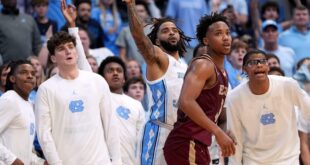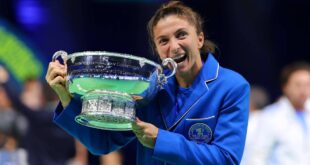Real Madrid coach Carlo Ancelotti was in typically relaxed form when he spoke to the media before Tuesday’s La Liga game at home to Deportivo Alaves this week.
“I’ve been lucky enough to coach 300 games at the best club in the world,” Ancelotti said. “To be on this bench is something special. To sit there 300 times… I’m not saying it’s a miracle, but almost.”
To reach such a milestone at any big European club is a superb achievement. It is especially impressive at Real Madrid, given president Florentino Perez’s history of hiring and firing coaches. Only one manager has taken charge of more games at Madrid: Miguel Munoz, with 605 between 1959 and 1974.
It helps that during both of Ancelotti’s spells as Madrid manager (he was in charge from 2013-2015 and returned in 2021) the team won the Champions League, first in 2014 and then in 2022 and 2024. But winning trophies alone is often not enough to ensure job security at the Bernabeu.
Just 12 months after delivering Madrid’s long-awaited tenth European Cup in 2014, Ancelotti was fired by Perez as serious issues arose in their relationship. His second spell has also featured several rocky moments — while also delivering two more Champions League titles.
To survive, and thrive, in arguably the most demanding environment in football is, as Ancelotti himself recognised this week, almost miraculous.
So how has he done it?
Over almost three decades working as a manager (he started at Italian club Reggiana in 1995), Ancelotti has acquired plenty of experience working for big characters used to issuing orders and seeing them quickly followed.
At AC Milan (2001-2009), Silvio Berlusconi was the owner — as well as the domineering prime minister of Italy for part of Ancelotti’s spell. His ultimate boss at Chelsea (2009-2011) was Roman Abramovich, a secretive Russian oligarch. At Paris Saint-Germain (2011-2013), the president was Nasser Al Khelaifi, a close associate of the ruling powers in Qatar.
Between his spells at Madrid his superiors were Bayern Munich’s self-confident president Uli Hoeness (Ancelotti was there for 2016-17), Napoli’s larger-than-life president Aurelio de Laurentiis (during 2018-19) and Everton’s majority owner Farhad Moshiri (2019-2021).
Ancelotti’s 2016 book — Quiet Leadership: winning hearts, minds and matches — includes a whole section on “managing up”, discussing his experiences dealing with colourful and powerful bosses.

GO DEEPER
Real Madrid’s Carlo Ancelotti — the Galactico whisperer and king of cups
Co-written with former Chelsea director Mike Forde and management consultant Chris Brady, it was published between the Italian being fired by Madrid in June 2015 and him joining Bayern the following summer.
At Milan, Ancelotti wrote, it soon became clear certain realities had to be accepted: “With Berlusconi I learned very quickly that, since he owned Milan, my job was to please Berlusconi.”

Ancelotti and Silvio Berlusconi pictured in January 2006 (Giuseppe Cacace/AFP via Getty Images)
On joining Chelsea, Abramovich instructed him to play a possession-based style of football. To do so, Ancelotti asked for playmaker Andrea Pirlo but when that was not possible, he used Michael Essien in that role. The book does not complain, but readers will know these are two very different types of players.
Ancelotti could handle not getting everything he wanted in the transfer market but it was more problematic that every time Chelsea lost a game, Abramovich arrived to personally demand answers.
“(That) taught me how to deal with this different kind of president,” Ancelotti wrote in his book. “I chose not to meet aggression with aggression, it is not my way. I like to think through difficult times, address the problems coolly and with reason.”
Ancelotti decided to use the owner’s interference in his job to motivate the team — and they won a Premier League and FA Cup double in his first season in charge. He wrote that the players knew Abramovich was “on my case” and they “responded brilliantly”.
It was difficult for that approach to succeed in the long term, and Abramovich fired Ancelotti after the following season ended trophyless. Next, he joined PSG, where the general director was Leonardo, “a friend of mine from Milan”.
Within 12 months it was clear things were not going to work out. After PSG lost to Ligue 1 rival Nice in December 2012, Leonardo told him he would be sacked if they did not beat Porto in their next game. Ancelotti realised Al Khelaifi had decided that the ‘project’ was not working, so he informed his bosses he would leave at the end of the season.
Next stop was the Bernabeu, where Ancelotti quickly realised he should just focus on coaching the first team and not worry about things outside his control. In his book, he wrote about realising “you are only ever a piece of the project” at Real Madrid. He said accepting that liberated him to focus on getting the best out of his players.
Following three seasons of predecessor Jose Mourinho’s pragmatic approach, Perez wanted a more attractive style of football at Madrid. Ancelotti set to work, allowing senior figures Sergio Ramos, Xabi Alonso, Cristiano Ronaldo and Luka Modric greater responsibility. He also devised new roles for Gareth Bale and Angel Di Maria within a 4-3-3 tactical shape. It delivered ‘La Decima’ in his first season.

GO DEEPER
Real Madrid’s Champions League suffering – until ‘La Decima’ changed everything
The strength of the relationships Ancelotti built is shown by Ronaldo guest-writing a chapter in Quiet Leadership.
“One of the reasons the atmosphere was so good was because Carlo protected the dressing room from the president and anything else that might upset the balance of the family,” Ronaldo wrote. “I’ve seen that he does not bow to pressure from anyone: he makes his own decisions.”

Ancelotti and Ronaldo celebrate reaching the 2014 Champions League final (Stuart Franklin – UEFA/UEFA via Getty Images)
Yet not all was perfect. Quiet Leadership also tells of Perez informing Ancelotti that Bale’s agent said his client wanted to play more centrally on the pitch. The Italian spoke directly with the player, explaining the team’s setup, and his vital role in it. He also used a press conference to tell the agent to “shut up”. Ancelotti wrote that this changed his relationship with Perez.
When Madrid lost a few games in early 2015, the club hierarchy grew concerned at a report claiming that Madrid’s training sessions were not intense enough. Ancelotti thought the squad needed more rest, especially with important players Ramos and Modric injured. The issue was never resolved, and when the season ended without a major trophy, the axe came.
Ancelotti wrote that his time at Madrid was “shorter than he’d hoped, but also longer than many who manage there”.
He added: “Leading may sometimes involve compromise, especially at the biggest clubs, but not when it comes to your expertise and you have the conviction of your decisions.”
Returning to Madrid in summer 2021, Ancelotti was well aware of the issues that caused friction the first time around. He accepted without complaint the club adding fitness coach Antonio Pintus to his staff, and repeated often that energy and physicality were vital for success in today’s game.
But he also insisted on bringing his own son Davide, then 34, as his assistant coach. This raised eyebrows at the Bernabeu, where the number two has often been a former club legend with the president’s ear. Ancelotti talks in his book a lot about how his closest staff are like a family. Now that was literally the case.

GO DEEPER
Carlo Ancelotti’s Real Madrid reinvention shows why he should be counted among the greats
Ancelotti was also well aware that the president would continue to have the final say on transfer policy. That meant adapting tactics to the current squad. The team sat deeper, meaning less running for veteran midfielders Toni Kroos and Modric, and more space for Vinicius Junior to exploit. Balance came from midfielder Federico Valverde on the right wing. It paid off when Valverde assisted Vinicius Jr’s winning goal in the 2021-22 Champions League final against Liverpool.

Ancelotti is mobbed after Madrid’s victory in the 2022 Champions League final (Jose Breton/Pics Action/NurPhoto via Getty Images)
When Karim Benzema left for Saudi Arabia in summer 2023, Ancelotti wanted England captain Harry Kane as a direct replacement. That option was not seriously pursued by Perez, so instead he created a new attacking role for Jude Bellingham, who scored 23 goals as Madrid won the La Liga and Champions League double last season.
Such success was far from inevitable. In May 2023, Madrid were thrashed 4-0 by Pep Guardiola’s City in a decisive Champions League semi-final second leg, just as Xavi’s Barcelona were easily winning the La Liga title. It was a rocky spell not unlike that which ended Ancelotti’s first term at the Bernabeu.
Ancelotti had an easy escape route — Brazil wanted him as their next national coach. His first option was always to remain in the Spanish capital, but speculation continued well into the 2023-24 campaign, with Ancelotti’s contract due to expire in June 2025.
It was an awkward situation, as Perez is not used to any coach having such strong bargaining power. The Bernabeu hierarchy considered other options, including Bayer Leverkusen coach Alonso. Meanwhile, Ancelotti’s team went on a 17-game unbeaten run, winning 14 and drawing three, including a 2-1 Clasico victory at Barcelona, putting them in control of the La Liga title race. In late December, he was offered an extension to 2026 and accepted.
“I can’t control the direction of the president, I can only hope to influence him, and the best way to do that is by winning,” Ancelotti wrote in his 2016 book.
There was another awkward moment just last month. The Ancelottis wanted Madrid to hire 38-year-old Stockport County coach Andy Mangan, who is close to Davide. Not everyone at the Bernabeu liked the idea, and in the end the Spanish authorities refused Mangan a work permit.
That came amid a feeling around the Bernabeu that Madrid have not started the new season well, with departed playmaker Kroos badly missed. Stuttgart having more possession (54 per cent to Madrid’s 46 per cent) in last week’s Champions League group game at the Bernabeu fed a debate about the team’s style of play (even though Madrid won 3-1).
Afterwards, Ancelotti faced tough questioning from reporters well aware that Perez prefers to see his team dominating possession and playing stylish attacking football.
“Maybe we could play better, but Real Madrid fans are used to seeing ‘rock and roll’ football, not lots of touches,” he responded coolly. “We try, with our characteristics, to make the fans happy. The fans like winning more than playing well. The ideal is to win and play well.”

Ancelotti with his Real Madrid players in pre-season this August (Victor Carretero/Real Madrid via Getty Images)
It was typical Ancelotti. He made the point that his squad, especially in midfield and attack, is made up of players suited to football that is “entertaining, direct, intense, with pace”. The underlying message was that he was making the best of the players available, while everyone knew he was not primarily responsible for assembling the squad. It was all delivered calmly, showing he was in control of the situation and nobody should worry.
Not all top managers react to criticism, or interference from above, in such a way. With some, their ego gets in the way. But at this stage of his career, and his life, the 65-year-old Ancelotti has sufficient self confidence to not react to treatment others might take personally. His experience of dealing with many different owners and presidents has taught him to be philosophical.
“I’ve learned that getting sacked — and getting recruited for that matter — is rarely just about you,” Ancelotti wrote in Quiet Leadership. “It is always about the person hiring or firing you. Do your job to the best of your ability and let others judge you because they will anyway.”
In another section of the book, he puts it differently.
“As Vito Corleone would have said in one of my favourite movies, The Godfather, ‘It’s not personal. It’s just business.’”
(Top photo: Angel Martinez – UEFA/UEFA via Getty Images)
Source link
 meganwoolsey Home
meganwoolsey Home



